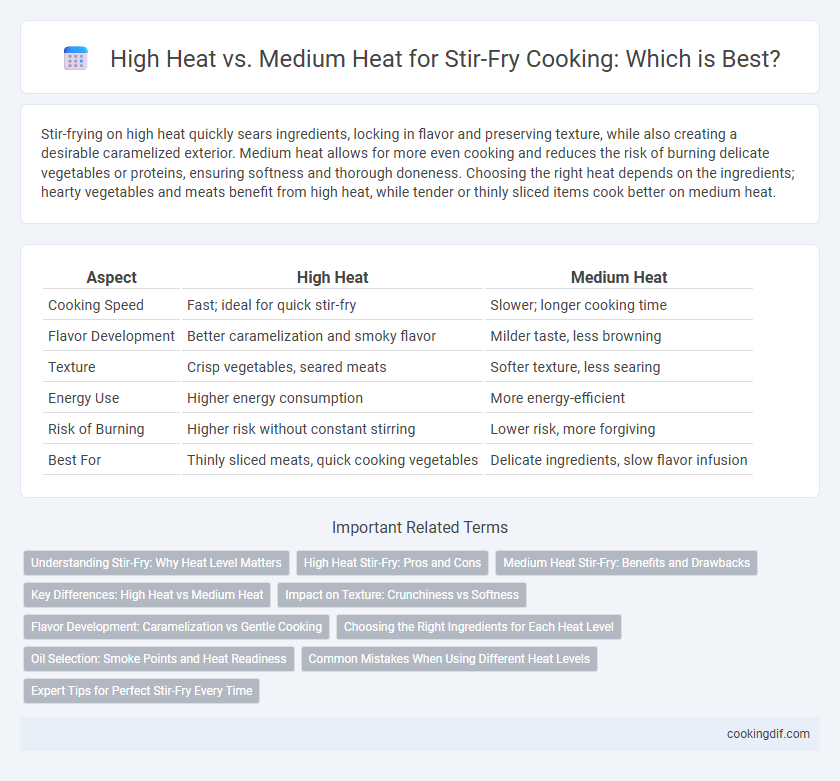Stir-frying on high heat quickly sears ingredients, locking in flavor and preserving texture, while also creating a desirable caramelized exterior. Medium heat allows for more even cooking and reduces the risk of burning delicate vegetables or proteins, ensuring softness and thorough doneness. Choosing the right heat depends on the ingredients; hearty vegetables and meats benefit from high heat, while tender or thinly sliced items cook better on medium heat.
Table of Comparison
| Aspect | High Heat | Medium Heat |
|---|---|---|
| Cooking Speed | Fast; ideal for quick stir-fry | Slower; longer cooking time |
| Flavor Development | Better caramelization and smoky flavor | Milder taste, less browning |
| Texture | Crisp vegetables, seared meats | Softer texture, less searing |
| Energy Use | Higher energy consumption | More energy-efficient |
| Risk of Burning | Higher risk without constant stirring | Lower risk, more forgiving |
| Best For | Thinly sliced meats, quick cooking vegetables | Delicate ingredients, slow flavor infusion |
Understanding Stir-Fry: Why Heat Level Matters
Stir-fry cooking demands precise heat control, with high heat rapidly searing ingredients to preserve their crispness and vibrant flavors, while medium heat allows for more gradual cooking and thorough flavor development without burning. High heat is essential for authentic stir-fry techniques, enabling quick caramelization and retaining the freshness of vegetables and proteins. Medium heat suits delicate or thicker ingredients that require even cooking time to avoid toughness and ensure tenderness.
High Heat Stir-Fry: Pros and Cons
High heat stir-fry cooks ingredients quickly, preserving crisp textures and vibrant colors essential for dishes like beef and vegetable stir-fry. However, using high heat demands constant attention to prevent burning and uneven cooking, which can result in charred flavors. This method is ideal for thinly sliced meats and hardy vegetables but may not suit delicate ingredients prone to overcooking.
Medium Heat Stir-Fry: Benefits and Drawbacks
Medium heat stir-frying allows vegetables and meats to cook evenly while preserving nutrients and preventing burning, which enhances natural flavors and textures. This temperature control reduces the risk of overcooking and maintains a tender, juicy consistency, ideal for delicate ingredients like bell peppers and shrimp. However, medium heat may require longer cooking times, potentially resulting in less crispness compared to high heat stir-frying.
Key Differences: High Heat vs Medium Heat
High heat in stir-frying sears ingredients quickly, locking in moisture and creating a crispy texture ideal for vegetables and thinly sliced meats. Medium heat allows for slower cooking, enhancing flavor development and preventing burning but may result in softer textures. Choosing high heat maximizes Maillard reactions and retains bright colors, while medium heat offers more control for delicate ingredients and complex sauces.
Impact on Texture: Crunchiness vs Softness
High heat in stir-frying sears vegetables and proteins quickly, maintaining their crunchiness and vibrant texture by locking in moisture. Medium heat allows ingredients to cook more slowly, resulting in a softer texture as fibers break down and release more moisture. Choosing high heat preserves crispness essential for authentic stir-fry dishes, while medium heat creates tender, less crispy results.
Flavor Development: Caramelization vs Gentle Cooking
High heat cooking in stir-fry promotes intense caramelization, creating deeper, complex flavors and a desirable crispy texture. Medium heat allows for gentle cooking, preserving the natural sweetness and moisture of ingredients without over-browning. Balancing these heat levels enhances both flavor development and texture in stir-fried dishes.
Choosing the Right Ingredients for Each Heat Level
High heat is ideal for stir-frying thinly sliced vegetables and proteins like bell peppers, shrimp, and beef, as it quickly sears the ingredients, locking in flavor and texture. Medium heat suits denser vegetables such as carrots, broccoli, and snap peas, allowing them to cook evenly without burning or becoming mushy. Selecting the right ingredients for each heat level ensures optimal texture and taste in every stir-fry dish.
Oil Selection: Smoke Points and Heat Readiness
Choosing the right oil for stir-frying hinges on its smoke point, with high heat cooking favoring oils like avocado, peanut, or refined vegetable oils that withstand temperatures above 400degF (204degC) without breaking down. Medium heat stir-frying allows for the use of oils with lower smoke points, such as olive oil or sesame oil, which enhances flavor without risking the formation of harmful compounds. Ensuring the oil reaches the appropriate heat readiness before adding ingredients maximizes flavor development and prevents food from sticking or absorbing excess oil.
Common Mistakes When Using Different Heat Levels
Using high heat in stir-fry often leads to burnt ingredients and uneven cooking, especially when the wok or pan is overcrowded, preventing proper heat distribution. Medium heat, while safer to avoid burning, can cause vegetables to steam rather than sear, resulting in a soggy texture and loss of vibrant color. Balancing heat levels by preheating the wok on high and then adjusting to medium ensures ingredients cook evenly without sacrificing the characteristic stir-fry crispness.
Expert Tips for Perfect Stir-Fry Every Time
High heat is essential for achieving a quick sear and preserving the crisp texture of vegetables in stir-fry, while medium heat helps prevent burning and allows delicate ingredients to cook evenly. Experts recommend preheating the wok until it's smoking hot before adding oil and ingredients to maximize flavor development through the Maillard reaction. Maintaining high heat with constant stirring ensures fast cooking and vibrant colors, making every stir-fry dish perfectly balanced in texture and taste.
High heat vs Medium heat for cooking Infographic

 cookingdif.com
cookingdif.com